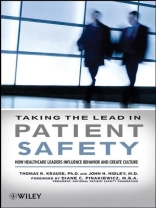* Written by industry professionals: a workplace safety
specialist in conjunction with a practicing physician and medical
manager.
* Provides recommendations for assessing hospital safety
practices as well as specific suggestions for behavioural
interventions.
* Brings a systematic approach to healthcare safety, identifying
common problems through illustrative case studies and offering
solutions.
* Offers several different perspectives including patient safety,
doctor safety, and administrator safety.
Tabela de Conteúdo
Foreword by Diane C. Pinakiewicz, M.B.A.
Acknowledgments.
Introduction.
Think leadership.
Think systems.
Think strategy.
Think culture.
Think behavior.
About this book.
1. What Determines Patient Safety?
Why make safety happen?
What stands in the way of improved healthcare safety?
Whose job is it to take the lead?
2. Blueprint for Healthcare Safety Excellence.
The working interface: Where exposure to hazard can occur.
Healthcare safety-enabling elements.
Organizational sustaining systems.
Organizational culture.
The charge of the safety leader.
3. Nine Dimensions of Organizational Culture.
Measuring culture with the Organizational Culture Diagnostic
Instrument.
Organizational dimensions: The four pillars of culture.
Team dimensions.
Safety-specific dimensions.
Why do some organizations change more readily than others?
4. Qualities of a Great Safety Leader.
The Safety Leadership Model.
Measuring leadership with the Leadership Diagnostic Instrument
(LDI).
Personal safety ethic.
Leadership style.
5. Leadership Best Practices.
Vision.
Credibility.
Action orientation.
Collaboration.
Communication.
Recognition and feedback.
Accountability.
Measuring leadership best practices with the LDI.
6. Changing Behavior with Applied Behavior Analysis.
What is behavior change?
Antecedents, behaviors, and consequences.
ABC analysis.
Putting the tools to work in your organization.
7. Protecting Your Decision Making from Cognitive
Bias.
Tragedy on Mount Everest.
Cognitive bias and healthcare safety.
Biases of data selection.
Biases of data use.
Case study: Cognitive bias in manufacturing.
Putting your cognitive bias knowledge to work.
8. Designing Your Safety Improvement Intervention.
The Leading with Safety process.
Phase I: The Patient Safety Academy.
Step 1: Gain leadership alignment on patient safety as a
strategic priority.
Step 2: Develop a patient safety vision.
Step 3: Perform a current state analysis.
Step 4: Develop a high-level intervention plan for phase II.
9. Launching Culture Change for Patient and Employee
Safety.
Phase II: Achieving safety throughout the organization.
Step 5: Engage the organization in the Leading with Safety
process.
Step 6: Realign systems, both enabling and sustaining.
Step 7: Establish a system for behavior observation, feedback,
and problem solving.
Step 8: Sustain the Leading with Safety process or continual
improvement.
Case history: Exemplar Health Net.
Leadership Coaching.
10. NASA After Columbia: Lessons for Healthcare.
NASA’s approach to culture and climate transformation.
Assessing NASA’s existing culture and climate.
BST’s NASA intervention.
Results at NASA.
Lessons for healthcare.
Bibliography.
Index.
Sobre o autor
Thomas R. Krause, Ph.D., is chairman and cofounder of
Behavioral Science Technology, Inc. (BST), a global safety
consulting and solutions firm. He is the author of four books,
including Leading with Safety, and has written more than 50
articles on safety systems, culture, and leadership. Dr. Krause,
who serves on the editorial board of the Journal of Behavior
Analysis in Health, Sports, Fitness and Medicine, is a member of
the American Society of Safety Engineers and the American
Psychological Association.
John H. Hidley, M.D., cofounder of BST, is board
certified in neurology and psychiatry. Dr. Hidley, who practiced in
the U.S. Air Force and privately, publishes frequently on safety
and leadership issues. He has contributed to The Behavior-Based
Safety Process, Current Issues in Behavior-Based Safety, and
Leading with Safety.












